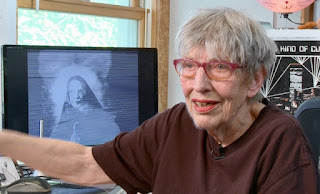Digitizing Videotape: Already Too Late?
A Story of 3/4-inch tape Duplication "Another day older and what do you get?"*
Update: 2020, Thanks to Craig's and several other local producer-production companies, corporate and educational institution donations, MNMA now has an active "Media Conversion Transfer lab" with functioning formats including... EIAJ 1/2" Open Reel, 3/4" Umatic, Betacam-SP and 1"' TypeC. Call Ron or Mark for more information, 612-361-7476 . https://mnmediaarts.org/
 |
| Craig Sinard |
According to Bob Herman, former Director of Marketing at Imation, no recording media lasts forever. Not nearly forever. DVDs? Nope. The glue eventually fails, and the top and bottom separate, leaving the recording medium exposed. Flash Drives? Guess again. The JEDEC JESD218 specifications put flash drive memory at 2 years. That Hard Drive you bought at Best Buy? Maybe 5 years. And Videotape? New videotape can last years! But assuming we’re talking about tape that’s been in your closet or basement for 20 years already, you’re beyond your expiration date. The oxide that holds the images eventually flakes off (if it doesn’t mold first). So when I discovered a long-lost box with 13- 3/4 U-matic videotapes, I could only groan!
 |
| 13 analog videotapes transferred to a digital 64 Gb drive in green circle. |
Minneapolis Video Artist Mike Rivard had told me horror stories of trying to get quality digitization of his ancient collection. Stories of places that didn’t examine the tape, didn’t test the tape, didn’t condition the tape — just tossed it on a machine and hit playback. Finding a place that understood professional concerns became a priority.
After many hours searching articles, I settled on three places to ask about digitization for 3/4 U-matic inch videotape:
⁃ ADS (aka Advanced Duplication Services) of Plymouth, MN. I selected ADS because I have hired them in the past to create 500,000 DVD’s at a time for my clients. I wanted to see how they compared when it came to "tiny-quantity" videotape dupe order.
⁃ Astound Duplication, 4 locations in the Twin Cities. I included Astound because they have a good reputation in the region, and I wanted an example of a "normal" neighborhood shop.
⁃ Media Burn in Chicago. The many reasons I included Media Burn in my vendor audit will become apparent in a moment.
The price results:
⁃ ADS ⁃ $150/tape + setup/media = $2185
⁃ Astound - $75/tape = $975+ setup/media
⁃ Media Burn - $70/footage-hour = $236.83
That ADS was comparatively expensive was no surprise - they are a volume duplication facility. Astound was reasonably priced by comparison. But it wasn’t until I looked at Media Burn that I realized I was searching for the wrong thing. Duplication is not the same business as archiving.
Don’t misunderstand - all duplicators need to be contentious and careful, or they won’t stay in business. It’s a tough, commoditized business. But it now appears that archivists are a different breed.
Media Burn is a 501(c)3 nonprofit whose mission is "preserving documentary films and independently produced media and making them accessible to everyone, to global audiences, for free." No for-profit company I found says anything like this at their website:
Sara Chapman, unlike any other person I spoke to, said, "If your tapes have issues that require additional conservation, like baking or mold remediation, we'll contact you with options before proceeding.""Our transfer and preservation methodologies correspond to the highest national standards and have been recognized with grants from the National Archives and Records Administration, the National Endowment for the Humanities, National Endowment for the Arts, and others. We have twelve years of experience transferring tapes, and our happy customers include broadcast professionals, filmmakers, arts organizations, and major corporations."
One videographer commented that he was nervous about shipping. Sara’s response: “We've never experienced a lost a package through UPS or Fedex. Obviously, since your tapes are one of a kind, I’d use a method with tracking. [Also] We suggest shipping on Mondays so that the tapes don’t spend the weekend in a shipping facility. … Of course, we are cognizant of how fragile hard drives are, so we always maintain a backup onsite until the client tells us they received the drive and the files are in working order."
How about 1/2 inch EIAJ reel-to-reel videotape? Media Burn recommends these non-profits
- Bay Area Video Coalition in San Francisco (specialists in 1/2" EIAJ and other formats)
- Video Data Bank at the Art Institute in Chicago (specialists in 1/2" EIAJ)
Unfortunately, while they are considering it, Video Data Bank only digitizes their own holdings, which includes the entire Videofreex library. (Not reviewed: the for-profit companies Specs Bros in New Jersey and DC Video in Burbank.)
My thirteen 3/4 U-matic cassette tapes are now digitized to .avi and .mp4. I could have digitized to "RAW" (uncompressed) at no additional charge. But my engineer, Rich Brown agreed with Media Burns suggestion that 3/4 U-matic video doesn’t really require RAW, as the DV codec captures more information than 3/4 U-matic video has. Also, I don’t intend to import or compile these videos. They look absolutely great, including my Master’s Thesis "creative component" - a video about UCV, University Community Video from 1979.
So now, finally, I can organize my Vimeo and YouTube pages into my own self-curated gallery. Someday. Eventually. Thirteen 3/4 U-matic videos down, four 1/2-inch tapes and 200 Betacams to go!
* "16 Tons" attributed to both George S. Davis and Merle Haggard; popularized by Tennessee Ernie Ford
Recommended Reading:
Keeping Data For a Long Time by Tom Coughlin at Forbes Magazine
Technical article about different storage media
Posted from the Minnesota Media Arts Preservation project - http://mnmediaarts.org/


This comment has been removed by the author.
ReplyDelete